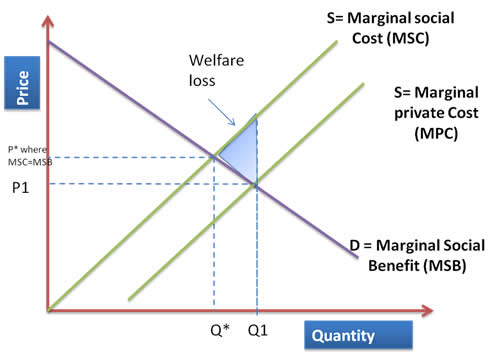Negative Production Externalities
Negative production externalities are the side-effects of production activities. As a result an individual or firm making a decision does not have to pay the full cost of the decision. Pollution created by firms due to production activities is an example of negative production externality.
In an unregulated market, producers don't take responsibility for external costs that exist--these are passed on to society. Thus producers have lower marginal costs than they would otherwise have and the supply curve is effectively shifted down (to the right) of the supply curve that society faces. Because the supply curve is increased, more of the product is bought than the efficient amount--that is, too much of the product is produced and sold. Since marginal benefit is not equal to marginal cost, a deadweight welfare loss results.
The diagram illustrates negative production externality.
The supply curve given by MPC reflects the firm’s private costs of production and the marginal social cost curve given by MSC represents the full cost of production to society. The vertical difference between MPC and MSC represents negative externality. Therefore for each level of output, Q1, social costs given by MSC are greater than the firm’s private costs by the amount of externality.
The optimal production quantity is Q*, but the negative externality results in production of Q1. The deadweight welfare loss is shown in blue.
Corrective Negative Production externalities
In order to correct negative externality of production and to bring down the production to the optimal level, government can intervene through the following options:
Legislation and regulations
Government can pass legislations to prevent or reduce the effects of production externalities. These legislations will lower the quantity of goods produced and bring it closer to the optimal quantity Q* by shifting the MPC curve upward towards the MSC curve. It might include legislations to
- Limit the emission of pollutants by setting limits to the extent of pollutants produced by a firm.
- Limit the production to a certain level.
- Force polluting units to install technologies which reduce emissions.
Putting Taxes
Government may impose a tax on the firm either on per unit of production or per unit of pollutants emitted. These will lead to a shift of MPC curve upwards towards the MSC curve and thus reducing output and bringing it closer to socially optimal level i.e. Q*. The diagram below shows the impact of taxes
Tradable permits
Tradable permits are a cost-efficient, market-driven approach to reducing greenhouse gas emissions. A government must start by deciding how many tons of a particular gas may be emitted each year. It then divides this quantity up into a number of tradable emissions entitlements - measured, perhaps, in CO2-equivalent tons - and allocates them to individual firms. This gives each firm a quota of greenhouse gases that it can emit over a specified interval of time. Then the market takes over. Those polluters that can reduce their emissions relatively cheaply may find it profitable to do so and to sell their emissions permits to other firms. Those that find it expensive to cut emissions may find it attractive to buy extra permits. Trading would continue until all profitable trading opportunities had been exhausted.
Tradable permits will result in firms to lower the quantity of goods produced so that it equals Q* and to raise the price of the goods.
Watch a Video







